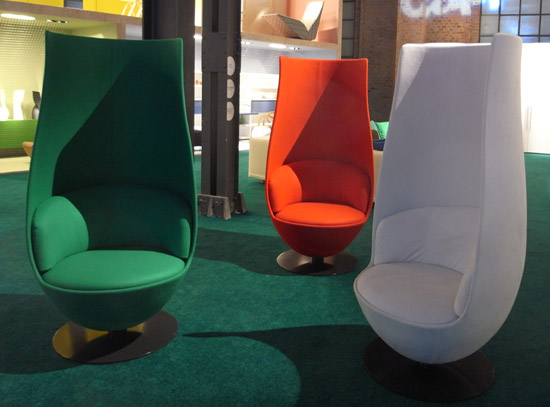Born on 02-07-1963, Boxtel, the Netherlands
Marcel Wanders studio Westerstraat 187
1015 MA Amsterdam the Netherlands
Ph +31 20 4221339
F +31 20 6815056
joy@marcelwanders.com
www.marcelwanders.com
HP de Tijd (NL) December 2007
Selected among Holland’s 100 most influential people
Identity (AE) November 2007
Selected among the World’s 50 design icons
Elected “Designer of the Year 2005/2006”, Elle Decoration International Design Awards
The Observer (UK) September 18, 2005
“Marcel Wanders' studio is one of the most inspiring powerhouses of multi-disciplinary design active today”
Washington Post (US) April 2003
“Marcel Wanders, the design world’s favorite star”
Business Week (US) July 2002
Selected among Europe’s 25 leaders of change “The Stars of Europe”
Summary
Marcel Wanders grew up in Boxtel, the Netherlands, and graduated cum laude from the School of the Arts Arnhem in 1988.
Marcel Wanders’ fame started with his iconic Knotted Chair, which he produced for Droog Design in 1996. He is now ubiquitous, designing for the biggest European contemporary design manufacturers like B&B Italia, Bisazza, Poliform, Moroso, Flos, Boffi, Cappellini, Droog Design and Moooi of which he is also art director and co-owner. Founded in 2000,
Moooi has grown into an internationally renowned design label. Additionally, Marcel Wanders works on architectural and interior design projects and recently turned his attention to consumer home appliances.
Marcel was the editor of the International Design Yearbook 2005. In the same year, together with Chef Peter Lute, he established the extraordinary LUTE SUITES hospitality-concept, the first “all over city suites” hotel in the world. He also designed the interior of Blits, a new restaurant in Rotterdam and the interior of the restaurant ‘Thor’ at the Hotel on Rivington in New York including bar, lounge and private club.
Marcel is the first and among the most important designers of Droog design. He was a juror for various prizes like the Rotterdam Design Prize (for which his own products were nominated several times) and the Kho Liang Ie prize. He lectured at SFMoMA, Limn, the Design Academy, Nike, IDFA, FutureDesignDays and has taught at various design academies in the Netherlands and abroad.
Various designs of Marcel Wanders have been selected for the most important design collections and exhibitions in the world, like the Museum of Modern Art in New York and San Francisco, the V&A Museum in London, the Stedelijk Museum in Amsterdam, Museum Boijmans van Beuningen in Rotterdam, the Central Museum in Utrecht, Museum of Decorative Arts Copenhagen and various Droog Design exhibitions. Coverage on Marcel has been published in all leading design magazines and newspapers such as Domus, Interni, Blueprint, Design Report, Frame, I.D. magazine, Abitare, Wallpaper, Nylon, Elle decoration, Icon, Esquire, the International Herald Tribune, Washington Post, the Financial Times, the New York Times and Business Week.
marcel wanders: cyborg for magis
'cyborg' is a series of three chairs by dutch designer marcel wanders for italian furniture
manufacturing company magis.
up close
image © designboom
installation view of the 'cyborg' chairs at the magis booth during milan design week 2010
image © designboom
in 1960 the term cyborg - which refers to an organism that has both artificial and natural systems -
was coined by manfred clynes. then in 1965, D.S. halacy's evolution of the superman,
featured an introduction which spoke of a 'bridge... between mind and matter.'
the friction we feel between the natural and artificial world is actually a misconception,
as there is no artificial world. there is only a natural world under the influence of its own nature.
we are part of this system of trial and error, survival of the fittest. in a way, everything has been
done before... there are no new ideas left... however, there are the occasions in which to create
new combinations, new connections between the things we take for granted and tangle them
in a way to create unexpected changes, poetic insights... technical twists which breathe a new life
into the world.
front view
wanders' 'cyborg' chairs utilize wicker in an unexpected way.
typically the durable woven fiber is used to construct a piece of furniture in its structural entirety.
here, wanders has combined the traditional material with plastic, developing a different aesthetic
with the two familiar materials. wicker has been woven in new patterns or formations utilized
as a structural back support for the seats, while the seat itself is made from a polycarbonate base.
'we have to remind ourselves of the story tales we were told as children, these well-intended lies
that taught us how to dream. as designers we have to lie like poets, to pair the unexpected to convey
our imaginative vision. we can enhance the world with a dream, a pairing. I love these little moments...
they are always welcome in my world!' - MW

side view

'cyborg'
image © designboom

detail of the wicker work
image © designboom

front view

side view

'cyborg'
image © designboom

front view

side view

technical description

'cyborg' sketches by marcel wanders

'cyborg' sketches by marcel wanders
marcel wanders: tulip armchair + flashback for cappellini
'tulip armchair'
image © designboom
'tulip armchair' created by dutch designer marcel wanders for cappellini is a reinterpretation
of the lengthened and oversized dimensions of the classic armchair. the frame is produced
in soft polyurethane and also co-injected with rigid polyurethane. meanwhile, the upholstery
is made in foam and acrylic layers. the fixed cover is available in a wide range of fabrics,
leathers and alcantara®, a sustainable industrial material that is carbon neutral in its production.
mimicking the stem of a flower, a shiny revolving base in dark varnished metal provides support
to the armchair.
86 cm x 86 cm x 40/160cm







0 σχόλια:
Δημοσίευση σχολίου